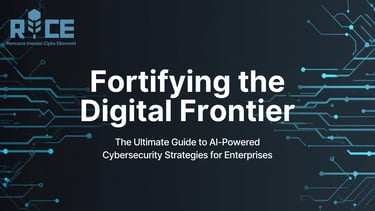Fortifying the Digital Frontier: The Ultimate Guide to AI-Powered Cybersecurity Strategies for Enterprises
Explore how AI is revolutionizing enterprise cybersecurity, offering essential strategies.
INDUSTRIES
Rice AI (Ratna)
11/20/20257 min read


The digital landscape is rapidly evolving, and with it, the sophistication and sheer volume of cyber threats. Enterprises today face an unprecedented barrage of attacks, from intricate ransomware campaigns to insidious nation-state intrusions. Traditional, signature-based cybersecurity defenses are increasingly overwhelmed, struggling to keep pace with polymorphic malware and zero-day exploits. The future of enterprise security demands a proactive, intelligent, and adaptable approach.
Artificial Intelligence (AI) is emerging not just as an enhancement but as a fundamental necessity in this ongoing digital arms race. This ultimate guide will delve deep into how AI is revolutionizing cybersecurity, offering a comprehensive look at its core capabilities, strategic implementation, and the critical considerations for enterprises looking to fortify their digital frontiers against tomorrow's threats. Prepare to navigate the complexities and harness the power of AI to build a truly resilient security posture.
The Shifting Sands of Cyber Threats: Why Traditional Approaches Are Failing
The escalating digital threat landscape presents an existential challenge for modern enterprises. Attackers leverage increasingly sophisticated tools and tactics, often outpacing manual human response times and static security solutions. This rapid evolution necessitates a paradigm shift in how organizations approach their cybersecurity defenses.
The Velocity and Volume of Attacks
Cyber threats now propagate at machine speed, generating an overwhelming volume of alerts that human analysts cannot possibly process effectively. This alert fatigue leads to missed critical incidents and delayed responses, creating significant windows of vulnerability. The sheer scale makes it impossible to manually correlate events and identify subtle attack patterns across vast networks.
Evolving Threat Vectors and Sophistication
Adversaries are no longer reliant on simple, known attack signatures. They employ polymorphic malware that constantly changes its code to evade detection, and sophisticated zero-day exploits that leverage previously unknown vulnerabilities. Phishing attacks are becoming hyper-personalized through social engineering, making them incredibly difficult to detect with traditional filters. Ransomware, supply chain attacks, and advanced persistent threats (APTs) further complicate the defense efforts, demanding intelligent, adaptive countermeasures.
AI as the New Digital Guardian: Core Capabilities
AI's strength lies in its ability to process, analyze, and learn from vast datasets with unparalleled speed and accuracy. In cybersecurity, this translates into transformative capabilities that empower enterprises to detect, predict, and respond to threats far more effectively than ever before. AI models can discern patterns and anomalies that would be invisible to human eyes or rule-based systems.
Anomaly Detection and Behavioral Analytics
One of AI's most potent applications is its capacity for anomaly detection. Machine learning algorithms establish baseline behaviors for users, networks, and endpoints by continuously monitoring activities. Any deviation from these established norms, no matter how subtle, can trigger an alert, indicating potential malicious activity. This goes beyond simple signature matching, catching novel threats that have no prior known signature.
Predictive Threat Intelligence
AI can analyze massive amounts of global threat data, including dark web forums, malware repositories, and attack trends, to predict future attack vectors and vulnerabilities. This predictive capability allows enterprises to proactively harden their defenses against emerging threats before they even materialize. It transforms cybersecurity from a reactive process into a foresightful strategy.
Automated Incident Response
Upon detecting a threat, AI can initiate automated responses, dramatically reducing the time attackers have to inflict damage. This might include isolating compromised endpoints, blocking malicious IP addresses, or rolling back systems to a pre-attack state. This rapid, automated intervention is critical in mitigating the impact of fast-moving cyberattacks.
Natural Language Processing for Security Operations
Natural Language Processing (NLP) extends AI's reach into unstructured data, like threat intelligence reports, security logs, and social media feeds. NLP models can extract crucial insights, summarize complex threat information, and even assist security analysts by processing human language queries, accelerating investigation and decision-making processes within the Security Operations Center (SOC).
Strategic Implementation of AI in Enterprise Cybersecurity
Integrating AI effectively into an enterprise's cybersecurity framework requires a strategic, multi-layered approach. It's not about replacing human experts but augmenting their capabilities, providing them with more precise tools and deeper insights. The goal is to create a dynamic, self-improving security ecosystem.
Endpoint Detection and Response (EDR) with AI
AI-powered EDR solutions move beyond traditional antivirus, continuously monitoring endpoint activity for suspicious behaviors. They can identify fileless malware, advanced persistent threats, and lateral movement within networks by analyzing process execution, file access, and network connections. This provides granular visibility and proactive protection at the device level, stopping threats before they escalate.
Security Information and Event Management (SIEM) powered by AI
Modern SIEM platforms leverage AI and machine learning to correlate billions of security events from across an enterprise’s infrastructure. AI enhances SIEM by identifying complex attack chains, reducing false positives, and prioritizing critical alerts, allowing security teams to focus on the most pressing threats. It transforms raw data into actionable intelligence.
Network Traffic Analysis (NTA) and User Behavior Analytics (UBA)
AI-driven NTA scrutinizes network traffic for anomalies indicative of stealthy attacks, such as command-and-control communications or data exfiltration attempts. UBA, on the other hand, profiles individual user behavior to detect deviations that might signal compromised accounts or insider threats. Together, they provide a comprehensive view of activity across the network and user base.
Cloud Security Posture Management (CSPM) and AI
As enterprises increasingly adopt cloud infrastructure, managing security across diverse cloud environments becomes complex. AI-powered CSPM solutions continuously monitor cloud configurations, identify misconfigurations, and ensure compliance with security policies. They can detect shadow IT and provide automated remediation for vulnerabilities within dynamic cloud native environments.
Data Loss Prevention (DLP) and AI
AI significantly enhances DLP capabilities by intelligently classifying sensitive data and monitoring its movement across the enterprise. It can detect attempts to exfiltrate confidential information, whether intentional or accidental, by understanding content and context rather than just keyword matching. This provides a more robust defense against data breaches.
At Rice AI, our solutions are engineered to seamlessly integrate these AI capabilities into your existing security architecture. We specialize in developing adaptive AI models that learn from your unique threat landscape, providing tailored protection that evolves with your enterprise. Our platform goes beyond generic threat detection, offering customized behavioral baselines and automated response playbooks to fit your specific operational needs. From real-time anomaly detection to predictive threat intelligence, Rice AI empowers your security teams with the cutting-edge tools necessary to stay ahead of the curve.
Navigating the Challenges and Ethical Considerations
While AI offers immense promise, its implementation in cybersecurity is not without its hurdles. Enterprises must approach AI adoption with a clear understanding of these challenges to maximize its benefits and mitigate potential risks. Ethical considerations are paramount to ensure fair and unbiased security practices.
Data Quality and Bias
AI models are only as good as the data they are trained on. Poor quality, incomplete, or biased training data can lead to skewed results, resulting in false positives, missed threats, or even discriminatory outcomes. Ensuring diverse, representative, and clean datasets is crucial for effective and ethical AI deployment. Rigorous data governance frameworks are essential.
AI Model Interpretability (Explainable AI - XAI)
Many advanced AI models, particularly deep learning networks, operate as "black boxes," making it difficult to understand how they arrive at their decisions. In cybersecurity, knowing why a threat was flagged is vital for investigation, auditing, and continuous improvement. Explainable AI (XAI) is an emerging field focused on making these models more transparent and interpretable for human analysts.
Adversarial AI Attacks
The very AI systems designed to defend can themselves become targets. Adversarial AI involves attackers manipulating input data to trick AI models into misclassifying threats or granting unauthorized access. Defending against these sophisticated attacks requires developing robust, resilient AI models and continuous vigilance against new evasion techniques.
Talent Gap and Upskilling
Implementing and managing AI-powered cybersecurity solutions requires a specialized skillset. There's a significant talent gap in the market for cybersecurity professionals proficient in AI, machine learning, and data science. Enterprises must invest in upskilling their existing teams and attracting new talent to effectively leverage these advanced tools. This includes training in AI ethics and governance.
The Future of Cyber Resilience: AI-Driven Defense-in-Depth
The integration of AI is not merely an incremental improvement; it represents a fundamental shift towards truly resilient and self-optimizing security architectures. The future of cybersecurity will be defined by systems that are not only proactive but also self-healing and continuously learning, creating layers of defense that adapt in real-time.
Proactive Threat Hunting
AI significantly enhances proactive threat hunting by sifting through massive datasets to identify subtle indicators of compromise (IOCs) and attack patterns that might otherwise go unnoticed. It empowers human threat hunters with intelligent leads, allowing them to investigate potential threats before they fully materialize. This shifts the security paradigm from reactive to highly predictive.
Self-Healing Systems
Imagine a network that automatically detects a breach, contains the affected systems, patches the vulnerability, and restores operations – all without human intervention. This vision of self-healing cybersecurity systems, powered by advanced AI and automation, is becoming increasingly attainable. AI orchestrates these complex responses, minimizing downtime and damage.
Integrated Security Ecosystems
The ultimate goal is to move towards a unified, intelligent security ecosystem where all components communicate and share threat intelligence seamlessly. AI acts as the central nervous system, correlating information from endpoints, networks, cloud environments, and identity systems to provide a holistic view of the security posture. This integrated approach allows for more efficient and effective defense-in-depth strategies.
This future requires solutions that are not just intelligent but also adaptable and scalable, capable of evolving with the threat landscape. Rice AI is at the forefront of this innovation, developing comprehensive AI security platforms that provide integrated visibility, proactive defense, and automated response capabilities. We empower enterprises to build security ecosystems that are truly future-proof, leveraging advanced machine learning to anticipate and neutralize threats before they can impact your operations. Partner with Rice AI to transform your cybersecurity from a challenge into a strategic advantage, ensuring your digital frontier remains impenetrable.
Conclusion
The journey to fortifying the digital frontier in the age of sophisticated cyber threats is an ongoing and complex one. Traditional security methodologies, while still relevant, are no longer sufficient to contend with the velocity, volume, and ingenuity of modern adversaries. Artificial Intelligence has emerged as the indispensable ally, fundamentally transforming how enterprises approach their cybersecurity strategies. Its capabilities in anomaly detection, predictive intelligence, automated response, and data analysis are not just enhancing existing defenses but creating entirely new paradigms of protection.
Embracing AI in cybersecurity means building a resilient, adaptive, and intelligent defense-in-depth strategy. It’s about empowering your security teams with tools that provide unparalleled visibility, automate tedious tasks, and deliver actionable insights at machine speed. While challenges such as data quality, interpretability, and the talent gap must be addressed diligently, the strategic advantages offered by AI far outweigh these hurdles. The future of enterprise security is inextricably linked with the intelligent integration of AI, leading towards proactive threat hunting, self-healing systems, and integrated security ecosystems.
As you look to the future, consider how your enterprise can harness these cutting-edge capabilities. The time to transition from reactive measures to a proactive, AI-driven defense is now. Are you ready to lead your organization into a new era of cyber resilience?
Visit Rice AI today to explore our advanced AI-powered cybersecurity solutions and discover how we can help you build an intelligent, impenetrable digital frontier. Our experts are ready to partner with you to tailor a strategy that secures your assets, protects your data, and safeguards your future.
#AICybersecurity #EnterpriseSecurity #DigitalFrontier #ThreatDetection #IncidentResponse #MachineLearningSecurity #CyberResilience #PredictiveAnalytics #SecurityOperations #AIinSecurity #DataProtection #NetworkSecurity #EndpointSecurity #CloudSecurity #FutureofCybersecurity #DailyAIIndustry
RICE AI Consultant
To be the most trusted partner in digital transformation and AI innovation, helping organizations grow sustainably and create a better future.
Connect with us
Email: consultant@riceai.net
+62 822-2154-2090 (Marketing)
© 2025. All rights reserved.


+62 851-1748-1134 (Office)
IG: @riceai.consultant
